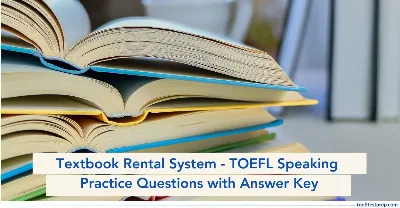Internet of Things - TOEFL iBT® Reading Practice Test

"Improve your TOEFL Reading abilities with our practice passage on 'Internet of Things,' focused on enhancing comprehension and critical thinking."
Key Highlights
In the TOEFL Reading section, you may encounter passages on topics like the 'Internet of Things (IoT),' exploring its applications and implications. Practising with such passages helps you identify main ideas, understand technical terms, and analyse relationships between concepts in complex texts.
By engaging with content on 'Internet of Things,' you’ll strengthen your ability to comprehend emerging technology themes and answer TOEFL questions with confidence. This type of preparation builds a strong foundation for handling diverse topics in the test.
Reading Instructions:
- You have 15 minutes to read the following passage and answer all 9 questions related to it.
- Most questions are worth 1 point, but the last question is worth more. The directions indicate how many points you will receive for that specific question.
- The specific section/paragraphs have been provided again with the question for ease of understanding and quick solution.
- Some questions include a word or phrase that is highlighted in the question as well as in the paragraph for quick reference.
The Internet of Things: Transforming Connectivity and Data Exchange
The Internet of Things (IoT) shows a major shift in how devices communicate and interact. It basically changes the tech landscape. IoT is a network of physical objects equipped with sensors, software, and other technologies that allow data to be collected and exchanged over the internet. This connectivity goes beyond traditional computing devices, including a wide range of everyday items, from household appliances to industrial machines. The rapid growth of IoT devices has been driven by advances in wireless communication technologies, especially the rollout of 5G, which provides the bandwidth and low delays needed for real-time data transmission. So, the IoT system is expanding unlike any other, with estimates suggesting billions of connected devices in the coming years.
One of the most important benefits of IoT is its possible to improve efficiency and productivity across various sectors. For example, in manufacturing, IoT-enabled machines can continuously monitor performance and predict maintenance needs. This reduces downtime and cuts working costs. In agriculture, smart sensors can provide real-time information on soil conditions. This helps farmers optimize irrigation and fertilization practices. This data-driven approach not only increases crop yield but also supports sustainable practices by minimizing resource waste. Also, the combining of IoT technologies is increasingly seen as a key part of achieving working excellence, as organizations use data analysis to guide decision-making.
But the widespread use of IoT comes with significant challenges, especially regarding security. The connectivity of devices creates multiple entry points for potential cyberattacks, raising concerns about the safety of sensitive data. The 2016 Mirai botnet attack, which took advantage of unsecured IoT devices to launch a large distributed denial-of-service (DDoS) attack, highlights the weaknesses in IoT systems. In response, manufacturers and developers face growing pressure to implement strong security measures, including encryption and regular software updates, to protect user data and maintain trust in IoT applications. Also, the lack of the same standards among IoT devices makes it harder to communicate between devices from different manufacturers, which can hinder innovation.
Also, the moral aspects of IoT deserve careful attention. The large amounts of data generated by IoT devices raise important questions about privacy and data ownership. For example, smart home devices that track user behavior can collect sensitive information, which could be misused if not properly protected. The potential for watching through IoT technologies has sparked debates about balancing convenience with individual privacy rights. As IoT continues to develop, it is crucial for policymakers and stakeholders to create clear rules that protect users while encouraging innovation. This regulatory framework must address the moral issues related to data collection and usage, ensuring that individuals keep control over their personal information.
The environmental impact of IoT is another important aspect that needs attention. While IoT technologies can help sustainability actions, like optimizing energy use in smart buildings, the production and disposal of IoT devices create significant environmental challenges. The fast pace of technology often leads to electronic waste, which can harm ecosystems if not managed properly. Therefore, manufacturers must adopt sustainable practices throughout the product lifecycle, from design to disposal. Actions like recycling programs and developing materials that break down naturally can help reduce the environmental impact of IoT devices. Also, promoting circular economy principles can encourage the reuse and refurbishment of devices, thereby decreasing waste.
In conclusion, the Internet of Things is a transformative force in modern society, offering unmatched opportunities for efficiency, innovation, and connectivity. However, the challenges related to security, ethics, and environmental sustainability must be addressed to fully realize the possible of IoT. As technology continues to advance, it is crucial for stakeholders including governments, businesses, and consumers to engage in ongoing discussions and collaboration. By doing so, they can ensure that the benefits of IoT are maximized while minimizing its risks. Ultimately, the future of IoT holds promise, but it requires a balanced approach that prioritizes security, moral factors, and environmental responsibility, paving the way for a more connected and sustainable world.
Directions: Once you have read the passage, answer the following questions.
Paragraph 1
The Internet of Things (IoT) shows a major shift in how devices communicate and interact. It basically changes the tech landscape. IoT is a network of physical objects equipped with sensors, software, and other technologies that allow data to be collected and exchanged over the internet. This connectivity goes beyond traditional computing devices, including a wide range of everyday items, from household appliances to industrial machines. The rapid growth of IoT devices has been driven by advances in wireless communication technologies, especially the rollout of 5G, which provides the bandwidth and low delays needed for real-time data transmission. So, the IoT system is expanding unlike any other, with estimates suggesting billions of connected devices in the coming years.
Factual Information Questions
- According to paragraph 1, what is the primary function of the Internet of Things (IoT)
- To enhance traditional computing devices
- To enable communication between physical objects
- To replace household appliances
- To limit the number of connected devices
Negative Factual Information Questions
- In paragraph 1, each of the following is mentioned as a characteristic of IoT EXCEPT
- It includes a variety of everyday items.
- It relies solely on wired communication technologies.
- It allows for data collection and exchange.
- It is expanding rapidly with the help of 5G technology.
Paragraph 2
One of the most important benefits of IoT is its possible to improve efficiency and productivity across various sectors. For example, in manufacturing, IoT-enabled machines can continuously monitor performance and predict maintenance needs. This reduces downtime and cuts working costs. In agriculture, smart sensors can provide real-time information on soil conditions. This helps farmers optimise irrigation and fertilisation practices. This data-driven approach not only increases crop yield but also supports sustainable practices by minimising resource waste. Also, the combining of IoT technologies is increasingly seen as a key part of achieving working excellence, as organisations use data analysis to guide decision-making.
Inference Questions
- What can be inferred from paragraph 2 about the impact of IoT on agriculture?
- It has no effect on crop yield.
- It complicates irrigation practices.
- It helps farmers make informed decisions.
- It is only beneficial for large-scale farms
Rhetorical Purpose Questions
- Why does the author provide examples of IoT applications in manufacturing and agriculture in paragraph 2?
- To illustrate the limitations of IoT technology
- To highlight the potential benefits of IoT across various sectors
- To suggest that IoT is only useful in specific industries
- To argue against the use of IoT in traditional practices
Paragraph 3
But the widespread use of IoT comes with significant challenges, especially regarding security. The connectivity of devices creates multiple entry points for potential cyberattacks, raising concerns about the safety of sensitive data. The 2016 Mirai botnet attack, which took advantage of unsecured IoT devices to launch a large distributed denial-of-service (DDoS) attack, highlights the weaknesses in IoT systems. In response, manufacturers and developers face growing pressure to implement strong security measures, including encryption and regular software updates, to protect user data and maintain trust in IoT applications. Also, the lack of the same standards among IoT devices makes it harder to communicate between devices from different manufacturers, which can hinder innovation.
Vocabulary Questions
- The word unsecured in paragraph 3 is closest in meaning to:
- protected
- vulnerable
- outdated
- complicated
Sentence Simplification Questions
- Which of the sentences below best expresses the essential information in the following text in paragraph 3? "The connectivity of devices creates multiple entry points for potential cyberattacks, raising concerns about the safety of sensitive data."
- The connectivity of devices is a major concern for manufacturers.
- The connection of devices can lead to security vulnerabilities.
- Cyberattacks are a common issue for IoT devices.
- Sensitive data is always at risk in IoT systems.
Paragraph 4
Also, the moral aspects of IoT deserve careful attention. The large amounts of data generated by IoT devices raise important questions about privacy and data ownership. For example, smart home devices that track user behaviour can collect sensitive information, which could be misused if not properly protected. The potential for watching through IoT technologies has sparked debates about balancing convenience with individual privacy rights. As IoT continues to develop, it is crucial for policymakers and stakeholders to create clear rules that protect users while encouraging innovation. This regulatory framework must address the moral issues related to data collection and usage, ensuring that individuals keep control over their personal information.
Purpose of the Passage Questions
- What is the main purpose of paragraph 4?
- To discuss the benefits of IoT in daily life
- To highlight the ethical concerns surrounding IoT data usage
- To explain how IoT can improve security measures
- To provide examples of IoT applications in smart homes
Paragraph 5
The environmental impact of IoT is another important aspect that needs attention. While IoT technologies can help sustainability actions, like optimising energy use in smart buildings, the production and disposal of IoT devices create significant environmental challenges. The fast pace of technology often leads to electronic waste, which can harm ecosystems if not managed properly. Therefore, manufacturers must adopt sustainable practices throughout the product lifecycle, from design to disposal. Actions like recycling programmes and developing materials that break down naturally can help reduce the environmental impact of IoT devices. Also, promoting circular economy principles can encourage the reuse and refurbishment of devices, thereby decreasing waste.
Insert Missing Sentence Question
- In paragraph 5, there is a missing sentence. The paragraph is repeated below and shows four letters (A, B, C, and D) that indicate where the following sentence could be added. These practices can significantly mitigate the negative effects of IoT on the environment." Where would the sentence best fit?
- The environmental impact of IoT is another important aspect that needs attention.
- While IoT technologies can help sustainability actions, like optimising energy use in smart buildings, the production and disposal of IoT devices create significant environmental challenges.
- Therefore, manufacturers must adopt sustainable practices throughout the product lifecycle, from design to disposal.
- Also, promoting circular economy principles can encourage the reuse and refurbishment of devices, thereby decreasing waste.
Paragraph 6
In conclusion, the Internet of Things is a transformative force in modern society, offering unmatched opportunities for efficiency, innovation, and connectivity. However, the challenges related to security, ethics, and environmental sustainability must be addressed to fully realize the possible of IoT. As technology continues to advance, it is crucial for stakeholdersincluding governments, businesses, and consumersto engage in ongoing discussions and collaboration. By doing so, they can ensure that the benefits of IoT are maximised while minimising its risks. Ultimately, the future of IoT holds promise, but it requires a balanced approach that prioritises security, moral factors, and environmental responsibility, paving the way for a more connected and sustainable world.
Prose Summary Questions
Directions: An introductory sentence for a brief summary of the passage is provided below. Complete the summary by selecting the THREE answer choices that express the most important ideas in the passage. Some sentences do not belong in the summary because they express ideas that are not presented in the passage or are minor ideas in the passage. This question is worth 2 points.
- The Internet of Things (IoT) is a significant development that impacts various aspects of modern life.
- IoT improves efficiency and productivity across multiple sectors.
- The environmental impact of IoT devices is negligible and easily managed.
- Security and ethical concerns must be addressed to fully realise the potential of IoT.
- Policymakers should ignore the challenges posed by IoT to encourage innovation.
- Sustainable practices are essential for reducing the environmental impact of IoT.
- What is the main purpose of the passage?
- To explain the technical aspects of IoT
- To discuss the benefits and challenges of IoT
- To promote the use of IoT in everyday life
- To highlight the history of IoT development
Answer Key with Explanation for TOEFL Reading Passage - Internet of Things
1. Answer: B
Explanation: The passage defines IoT as a network of physical objects that are equipped with sensors and software, allowing them to collect and exchange data over the internet. This clearly indicates that the primary function of IoT is to facilitate communication among various physical devices, rather than enhancing traditional computing devices or limiting the number of connected devices.
2. Answer: B
Explanation: The passage highlights that IoT devices utilize wireless communication technologies, particularly the advancements brought by 5G. Therefore, the statement that IoT relies solely on wired communication is incorrect and does not align with the information provided in the paragraph.
3. Answer: B
Explanation: The passage discusses how smart sensors provide real-time information on soil conditions, which allows farmers to optimize their practices. This implies that IoT contributes positively to decision-making in agriculture, enabling farmers to make informed choices that enhance productivity and sustainability.
4. Answer: B
Explanation:The examples given in the paragraph serve to illustrate how IoT can improve efficiency and productivity in different industries. By showcasing these applications, the author emphasizes the broad potential benefits of IoT, rather than its limitations or specific industry uses
5. Answer: B
Explanation: The term "unsecured" refers to devices that lack protection against cyberattacks, making them susceptible to breaches. Thus, "vulnerable" is the most fitting synonym, as it conveys the idea of being exposed to potential harm or risk.
6. Answer: B
Explanation: This sentence succinctly captures the essence of the original text, which discusses how the connectivity of devices creates multiple entry points for cyberattacks. It effectively conveys the idea that such connections can compromise security
7. Answer: B
Explanation: The paragraph focuses on the moral implications of IoT, particularly regarding privacy and data ownership. It discusses the need for regulations to protect users, which indicates that the primary aim is to address ethical concerns rather than to discuss benefits or applications.
8. Answer: C
Explanation: The missing sentence logically follows the discussion about the environmental challenges posed by IoT devices. It reinforces the need for sustainable practices as a solution to the issues raised in the preceding sentences.
9. Answer: B
Explanation: These three choices encapsulate the main ideas presented in the passage, highlighting the benefits of IoT, the need to address security and ethical concerns, and the importance of sustainability in mitigating environmental impacts
10. Answer: B
Explanation: To discuss the benefits and challenges of IoT the main purpose is to discuss the overall implications of IoT.
Also Read:
Featured Articles

Marriage Across Cultures - TOEFL Reading Practice Test
Improve TOEFL Reading with passages on 'Marriage Across Cultures,' delving into unique traditions, values, and global perspectives on marriage.
July 15, 2025
Writing Center Services - TOEFL Speaking Practice Test with Answers (Integrated)
Prepare for the TOEFL Integrated Speaking section with a practice test on 'Writing Center Services' and learn to improve score in TOEFL exam.
July 15, 2025
Tutorial Room Booking - TOEFL Speaking Practice Test with Answers (Integrated)
Prepare for the TOEFL Integrated Speaking section with a practice test on 'Tutorial Room Booking ' and learn to improve score in TOEFL exam.
July 15, 2025
Textbook Rental System - TOEFL Speaking Practice Test with Answers (Integrated)
Prepare for the TOEFL Integrated Speaking section with a practice test on 'Textbook Rental System' and learn to improve score in TOEFL exam.
July 15, 2025